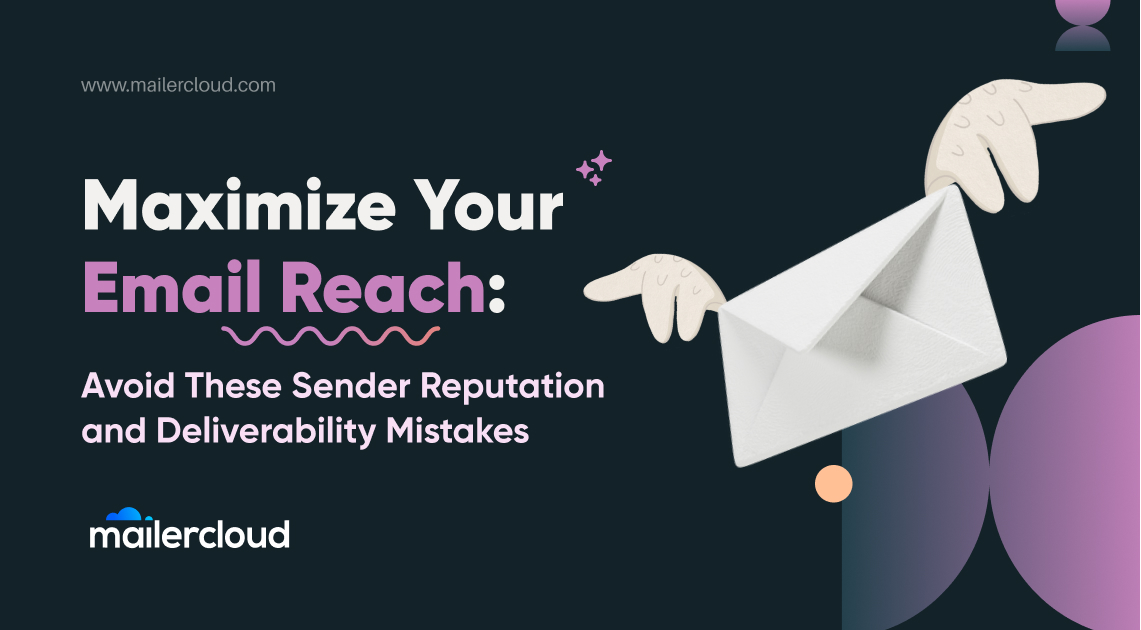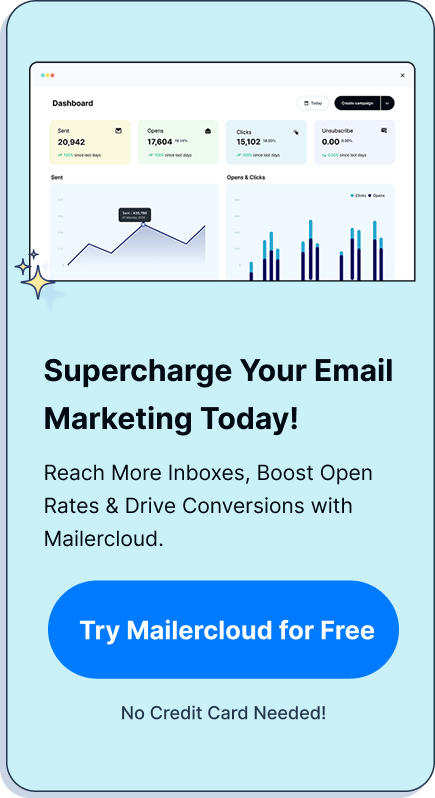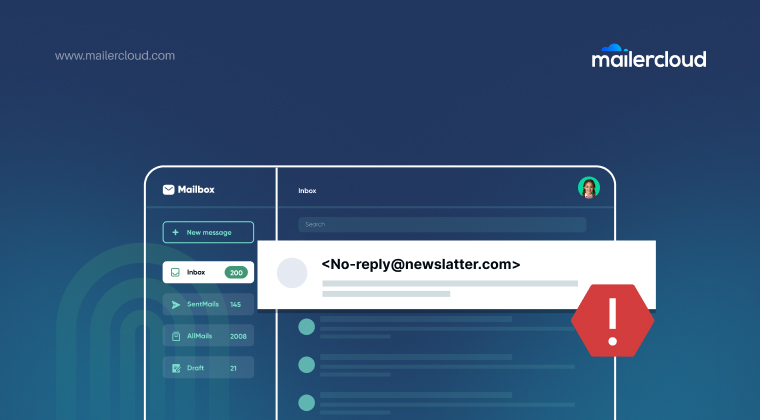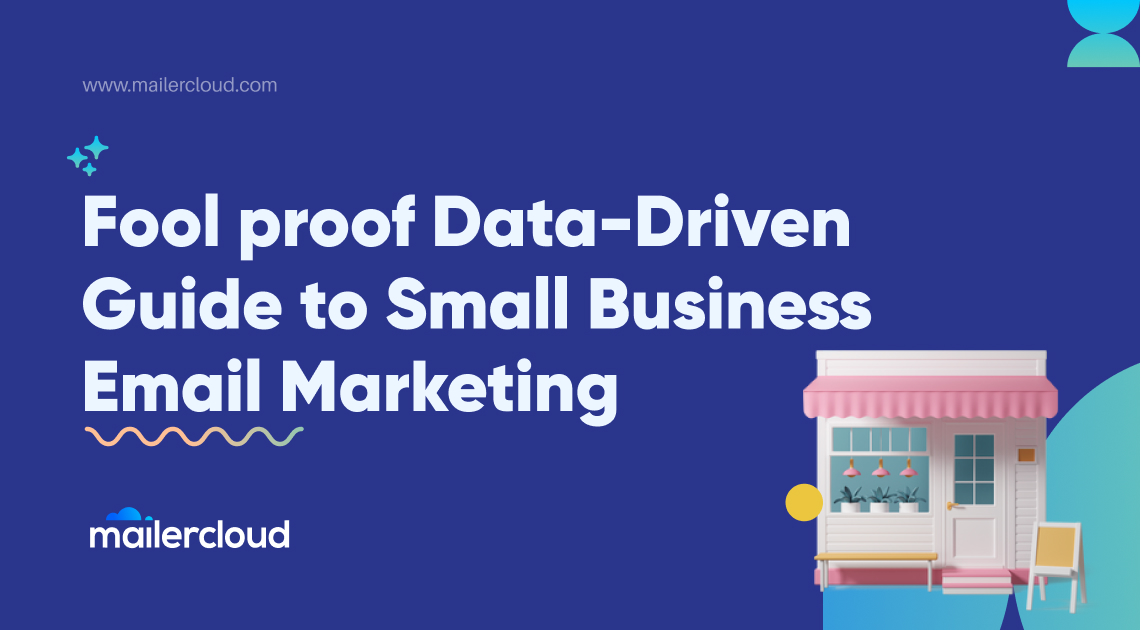People’s inboxes are packed with emails. It’s no surprise that they are becoming more and more selective, only opening emails that seem interesting to them. Email sender reputation is a vital consideration for both the sender as well as the receiver. It can make or break an email campaign and can lead to people deleting or blocking your messages from ever reaching their inboxes, thus decreasing the deliverability rates.
The first step towards improving your sender image is to avoid the mistakes that can affect it negatively. Maintaining a positive credibility is critical for any business that employs email as a marketing channel. Learn how to avoid common email sending blunders through this insightful guide.
Establishing and retaining a positive sender reputation is essential for ensuring that your emails get in your contacts’ inboxes rather than the spam bin. In fact, almost 20% of marketing emails never make it to the inbox of the intended recipient – Businesses leveraging email marketing see a negative impact on the email deliverability as well as ultimate success of lead creation, lead management, and retention.
Aside from the sheer number of users, email has recently become even more important. According to a study, there has been a 44% rise in email sends since the onset of the global pandemic as companies try to communicate how they are dealing with the new normal during and post pandemic. They keep their target audiences posted on changes, developments, and thus, stay on top of their minds through emails. With that, there has been a comparable rise in email open rates as well. This indeed demonstrates that people are interested in hearing what companies have to say and engaging with them via email.
However, if emails aren’t reaching subscribers’ inboxes, an email marketing strategy won’t yield the desired optimum results.
That is why it is critical to not only focus on building and maintaining a positive email sender reputation, and to understand what mistakes to avoid as a negative reputation affects email deliverability.
Table of Contents
What is email sender reputation?
Sender reputation is basically a score that an Internet Service Provider (ISP) gives to a correspondent that is sending marketing emails. A higher score indicates that an ISP is more likely to deliver emails to inboxes. In simple words, it indicates an email inbox if you’re a spammer or not. Email sender reputation or the sender score helps the email service providers to assess whether or not your email should be delivered to the intended inbox.
Why is Email Sender Reputation important?
Email reputation has direct implications on deliverability. Emails from a dispatching party with a lower reputation score are more likely to be rejected or forwarded to the spam bin automatically.
Each day, billions of emails are sent. But surprisingly, 45% of those emails are spam. Consequently, ISPs are always on a high alert when it comes to securing their customers’ inboxes from spam emails.
When an email arrives at the receiver server, the ISP gauges whether it is coming from a reliable dispatcher or not. In other words, an ISP will decide whether you will be allowed into the inbox based on your previous sending record, past user activity, and email quality, or if you will be filtered into the spam folder.
ISPs harness spam filters to protect their subscribers, weeding out any emails or dispatching parties that aren’t worthy of reaching their primary mailbox. If you have a high open and click through rate, few spam complaints, and a low bounce rate, your sender reputation will benefit and improve. On the other hand, if your emails have a poor open rate, few click-throughs, high rates, or your recipients flag your emails as spam, your reputation will deteriorate.
Protects recipients from being scammed: ISPs employ the correspondent’s reputation to detect and penalize cybercriminals who try to gain people’s trust through deception. Cybercriminals disguise themselves as well-known brands in order to dupe subscribers of personal information.
What is a good email sender reputation?
An acceptable sender reputation or sender score should be close to 90. A score of 90 indicates that your domain receives very few complaints and is almost never caught in spam traps.
The lower your score, the more likely your emails will find up in spam folders, going completely unnoticed. Poor customer feedback for your emails or emails with spam-sensitive content can result in poor sender reputation. Getting people to react to your emails on a regular basis is a sure-fire strategy to increase your reputation. You must actually be able to give something remarkable to encourage someone to spend attention away from their other online activities and focus on your email.
- Sender reputation is monitored and evaluated regularly
- Deliverability can fluctuate based on sender reputation
- Constant assessment of sender reputation impacts deliverability
How can you tell whether you have a bad email sender reputation?
Examining the outcomes over time is a proven approach to determine the health of your sending reputation. Patterns, tendencies, and irregularities are what you’re hunting for. The industry benchmark for open rates is at least 20%. So, if your open rates are much lower or have been declining over time, it’s a strong indication that your sending reputation is suffering.
One of the most obvious signs that your sending reputation is in need of repair is steadily dropping open rates, and this may be a difficult cycle to break. When email servers detect an absence of engagement with your emails, they may automatically block, bounce, or divert them to spam folders.
What causes the building of a bad sender reputation?
A substandard sender reputation is frequently the collective effect of all the outcomes of your emails at the receiving servers.
- Poor end results, such as high bounces, low email opens and engagement rates, may harm your sending reputation.
- Your email reputation will suffer if recipients mark your messages as spam, and future messages will be more likely to end up in the trash folder. It’s a terrible cycle: being labeled as spam earns you untrustworthiness, which raises your chances of being flagged again.
- Things can become even more difficult if your company employs a shared IP address. If you have an ip reputation issue with your address, anyone who uses it will have a problem as well.
When the intended audience opens and interacts with the emails, your sender reputation – and email deliverability – improves. No wonder, adhering to smart, productive email practices is critical.
Thankfully, you can improve your reputation to get more of your emails sent to subscribers’ inboxes – but it will take time to get your score back to where it should be. This is why it’s critical to establish a good sending reputation right from the starting.
In a nutshell, trying to make your data effective and compliant not just has an impact on a single email program, but also on the overall success rates of future campaigns.
Acknowledging that every action you take about data sources, email list quality, and data-driven email marketing content can have favorable or bad consequences for future is the starting point toward regaining control.
Mistakes that have an Impact on the Email Sender Reputation
1. Sending Emails to Misspelled Email Addresses
It’s common to misspell an address while manually entering it into a sign-up form, especially if the user is using a mobile device. Human mistake accounts for around 80% of all erroneous email contact data.
Your email would then bounce if you send it to a misspelled address (as it fails to deliver). When the email bounce rate rises, email providers will be less forbearing causing the majority of them to be labeled as spam.
One of the most significant components that forms the sender reputation is hard bounces. Email delivery is impossible if the email list database isn’t legitimate.
How to avoid this mistake?
The best way to dodge misspelled email addresses from getting into your list database is to put in place a double opt-in authentication method for new subscribers. Anybody who signs up gets an email requesting them to confirm their subscription by clicking a link. This validation further prevents any fraudulent activities as well.
Another alternative is to implement a real-time email verification tool to double-check an address before it enters into your marketing funnel. Invalid addresses are promptly recognized by an email verification application. In addition, if the user makes an unintentional typo, they will receive an error message. Before proceeding, the user will have the opportunity to correct their error.
2. Sending Emails to Purchased Email Lists
When businesses require new leads or users, they frequently turn to list data providers or brokers. Purchasing lists is a less time-consuming option in comparison to organically building a list, but it’s a terrible idea. This will have a detrimental influence on email engagement.
All of the leads you acquire from that list are non-organic, unfamiliar individuals who have no reason to trust your email because they don’t know who you are and for what you are sending the emails to them. Obviously, when you send an email to these unknown users, they are unlikely to respond and may even designate it as spam. Your emails will have a hard time getting past spam filters as a result of this.
Users must engage with your emails in order for you to have strong deliverability and build a positive and solid sender reputation. This implies they must read and respond to the emails you send.
If you send to contacts of a purchased list, you will not have established any trust with them yet. What makes you believe they’ll interact with your emails? Open rates will almost certainly be poor and unsubscribe rates will be extremely high. They’re unlikely to interact with your emails, which means you’re more likely to be flagged as spam.
Spam complaints play an important role in lowering your reputation. Each complaint you receive acts as a direct message to ISPs that their customers do not trust you. If your ISP receives too many spam complaints, they may eventually send all of your future emails straight to the spam bin and over time, may even block you.
How to avoid this mistake?
Concentrate on building your email list organically. Follow the three-step approach to build a list of genuinely interested contacts:
Step 1: Provide valuable incentives
The type of incentive or reward you offer may depend on your service or product and also on your brand’s style. You can use the following incentives:
- First-order discounts
- Free or express shipping upgrade
- Early access
- Exclusive promotional offers
- Contests
- Giveaways
Step 2: Offer easy and straightforward subscribe options
There are lots of methods to make subscribing to your email list as simple as possible. The key to determining which method is ideal for you is to understand your goals and select the one that optimally suits your requirements.
- Pop-ups
- Subscribe landing pages
- Social bar
- Slider
- Feature box
- Pop-up survey
- Scrolling header bar
- Checkout and sign-up forms
Step 3: Maintain the email list
Getting new subscribers takes effort and happens over time, but losing them can happen very quickly if you’re not diligent. You should also check to see whether your email list has any dead load. Not only will this lead to squandered emails, but it will also damage your email perception because of the poor engagement rates.
The best way to maintain your list quality and quantity is to ensure effective list segmentation and constantly keeping an eye on the bounce rates.
Apart from the three tactics mentioned above, one can also adopt the following practices smartly to build the list organically:
- High-quality and traffic-driving blogs.
- Use social media channels to create brand awareness.
- Provide an irresistible lead magnet: like free trial offer, a checklist, free product samples, free training videos.
- Reward website visitors: According to studies, 60% of consumers subscribe to an email newsletter to receive special offers and deals. Always remember that if you promise something in order to grow your list, you must deliver.
3. Following Poor Email List Hygiene Practices
An email account has a short lifespan, with most of them becoming inactive after only a year. Alternatively, some contacts who were once interested in receiving your emails may no longer want to receive marketing emails from you.
People deactivate accounts all the time and for plenty of reasons – whether it’s because they’ve changed their personal email address or because they’ve left a company, and their work address has been deactivated. Hence, removing such addresses from your list on a regular basis becomes critical. Keeping uninterested contacts there will just cost you more money. It’s also tough to understand the accurate subscribers’ interaction and create personalized content for them if your list data is outdated and not cleaned.
Users who do not open or click-through your email can cause more serious issues, tarnishing your reputation. Sending emails to inactive subscribers on a regular basis will result in hard bounces.
If a person has abandoned their account, for instance, they are not opening your emails. This will result in a hard bounce later on. They may also be uninterested in the content of your emails because they have already placed you in the spam folder without your knowledge.
How to avoid this mistake?
Set and follow a proper schedule to clean your email list. If not more frequently, clean your email contact lists at least once a quarter. If you’re not ready to delete a significant chunk of your contacts, learn how to segment your list to get comparable results.
4. Not Up to Par Email Content Quality
You’ve probably heard this before: content is always king. This is in fact true when it comes to working towards improving your email sender score.
Users are significantly more prone to complain and unsubscribe if you send out a poorly designed campaign with likewise lousy content. You’re well aware of how spam complaints harm your reputation, and poor content almost certainly offers the audience a reason to complain.
How to avoid this mistake?
- Create personalized and relevant content for the target audience.
- Crisp and benefit-focused email subject line.
- Reach a wider audience and increase the email open rates with a compelling preheader text.
- Each and every part of the content must provide value to the recipient.
- Design the emails in such a way that ensures easy accessibility and readability of the emails.
- Avoid using clickbait and spam words in the subject lines.
- Maintain a proper tone of the emails that is in-tune with your brand and business niche.
- A/B test the emails to find out which content style works best.
5. Sending Emails at Random Frequency
Email frequency is the fine line of demarcation between useful and annoying, timely and spammy, opt-in and opt-out. Thus, it is very essential to have the right email frequency to maintain a good sender reputation and email deliverability.
It may be difficult to establish and maintain your reputation if you send emails seldom. The metrics will only track the last 30 days of sending history. As a result, if emails from a given IP address are inconsistent, it is very likely that such emails will be blocked. The inbox will be unable to determine if an email from that IP address is spam or not, resulting in the email getting blocked.
Sending fewer emails will pave the path for engaged subscribers to lose their interest. Consequently, the inbox placement rates of the emails will suffer.
Sending too many emails frequently will annoy the recipients. Worse, it may prompt them to delete the emails or mark spam. From the ISPs point of view, these along with other declining metrics like the low engagement rates, low open rates act as red flags. Email service providers may put your email in the promotions tab, or worse, send it straight to spam, as your email reputation degrades.
How to avoid this mistake?
When deciding how often to send marketing emails, it’s a good idea to start by considering the purpose of your marketing campaigns in the first place.
- To get more online sales?
- To drive traffic to your specific webpage or online store?
- Generate brand awareness?
- Cultivate loyalty amongst your customers?
- Complete and close a transaction?
- All of the aforementioned?
Establish clear expectations with new subscribers right off the bat. You can tell them how many times each week they can anticipate to hear from you this way. Keep in mind your audience’s various time zones so that they don’t miss any vital information.
Allowing your subscribers to decide the frequency of your emails is an even better strategy than simply mentioning how often you’ll email them. To do so, you’ll need an email preferences section where subscribers may specify how frequently they’d like to hear from you.
Whatever the email frequency is – dependent on how many emails someone signed up for per month, week, or daily – make sure to tweak the content according to that only. You don’t want to send an email about a 48-hour weekend sale to somebody who won’t see it until Tuesday, after the sale has already expired.
6. Emailing to Spam Traps
Spam traps jeopardize your campaign’s credibility.
ISPs are aware that dispatchers have unethically sourced addresses when they send emails to addresses that are actually spam traps. Because people don’t use spam traps, the only way a spam trap can get up on an email list is if it was captured without permission.
Anyone who sends emails to an unethically sourced list exposes their sender domain to spam trap hits. The domain will very definitely be blacklisted as a result of this. Thus, many email marketers make the switch from one email marketing platform to another because their entire campaign is not delivered due to blacklisting.
Email spam traps are mainly of two types:
- Pristine Email Traps: These are those email addresses that are posted all over the internet by ESPs or blacklist organizers. The majority of them ended up on your list after being “scraped” or “harvested.” You may not be collecting data from the internet directly, but you never know whether one of your data providers has.
- Recycled Email Traps: All of those addresses that were formerly valid but are no longer in use by the user come under this category. The account is deactivated by the ISP, which will result in hard bounces. The ISP reactivates the inactive email account after several months.
7. Improper Email Authentication
In the email industry, impersonation isn’t flattery; it’s one of the fastest ways to ruin your reputation. You risk succumbing to email spoofing (someone gaining charge of your email domain) if you don’t enable Sender Policy Framework (SPF) and DomainKeys Identified Mail (DKIM). As a result, your deliverability will suffer.
How to avoid this mistake?
Using SPF and DKIM to authenticate your email shows ISPs that you are who you say you are and that you are worthy of sending email. Authenticating your account ensures that only a limited number of IP addresses are allowed to send emails from your domain.
Consider DKIM to be the signature you add to every campaign. The DKIM is strong evidence that the recipient’s ISP can use it to verify that the emails they’ve received are legitimate and the recipient has good ip and domain reputation. So, if the DKIM matches, the email is delivered to the inbox — all other factors being equal. If it doesn’t match, it’ll be redirected to the spam folder (or get a hard bounce).
Meanwhile, SPF is a list of the sender domain’s authenticated IP addresses. DKIM and SPF operate together to protect you from spoofing attacks, which occur when a source sends spam under the guise of another domain.
Apart from scrutinizing and verifying the DKIM and SPF authentication, the ISPs will also check for URLs, malicious content, and more to ensure that the email coming from your domain name is actually authorized by you.
It would be an understatement to say that a DKIM signature and SPF authentication have a substantial impact on your reputation. In other words, a recipient has no way of knowing who sent the email in the first place. An email that lacks authentication is suspicious in all forms.
Time to Improve your Email Sending Behavior and Sender Score
Set up a robust email sending infrastructure
Use the following tips:
- Leverage a strong, reliable and advanced email marketing tool that is flexible.
- Send marketing emails using a legitimate email address that reflects your business’s brand image. Sending from a “no-reply” address gives the impression that you don’t wish to communicate with the recipient and could be deemed spam.
- Configure an outbound email authentication if you utilize your own SMTP server with an in-house email system.
- Segment your complete email list database depending upon the campaign type. Segmenting emails for business, customer acquisition, customer retention, and transactional purposes further helps to easily create personalized email experiences for each segment of audience. Dispatchers who want to keep their reputations distinct can divide their email streams by IP address and publish separate SPF entries for each.
IP Credibility
The quality of your email sending ecosystem is referred to as IP credibility. Even if your content complies with industry-standard anti-spam rules, spam filters may detect it.
Improving your IP credibility is helpful in determining if the content is relevant and should be sent or forwarded to the spam bin by email receiving networks. It’s also critical to establish a strategy for various ISPs to guarantee that their subscribers are not inundated with spam. Having a dedicated IP address effectively helps to improve and maintain a good reputation without bothering about other senders’ negative actions.
Whitelisting
Your sender credibility will suffer if you are blacklisted by an ISP. It means that your emails will be marked as spam by spam filters and will not reach the inboxes of the recipients. And we’re sure you can’t afford to be put on a blacklist.
Whitelisting, on the other hand, has the opposite impact. It’s a tried-and-true method for improving your credibility.
What are your options for accomplishing this? Include a request to be whitelisted in your welcome email – Ask your subscribers to add you to their address book in a respectful manner.
Have feedback loops in place
Feedback loops are notifications from ISPs concerning complaints received from recipients of your emails. You get feedback if someone marks your email as spam or unsubscribes from your email list. Feedback loops are an excellent way to find out what your recipients dislike about your emails and to better your approach.
Warm-up your IP
It’s possible that creating your email address and blasting out thousands of emails right away would harm your credibility as a sender. Start slowly before conquering your entire email list. Warm up your IP by sending emails to a select set of your most loyal subscribers – those who value your content and are unlikely to report you as spam or unsubscribe. However, you should only send an email if you have anything worthwhile to say.
Be consistent with email volume, frequency and sender name
Make sure that the volume of emails you send and the frequency with which you send them are both constant. Sending 5,000 emails one day, 15,000 the next, and then silence for weeks will wreak havoc on your sender score. Maintain a consistent volume and pace across all email marketing campaigns. Keeping this aspect of your image in balance, however, requires some forethought.
Sending emails with a consistent sender name allows recipients to become familiar with your brand. When you send marketing emails from different names, it has the reverse effect: receivers have no idea who they’re hearing from or if they want to hear from them in the first place.
Gauge the level of engagement and work on improving it
Absence of engagement with the emails can often result in a bad sender reputation. You should think about retargeting to your unengaged subscribers.
A re-engagement campaign can assist you figure out whether subscribers are still interested and which ones of them aren’t. Sending out more personalized content in the re-engagement or win-back campaigns can prove to be a boon.
Sustaining customer engagement entails employing advanced email marketing tools and tactics to keep in touch with customers across all touchpoints.
Email automation
A professional email marketing tool will allow you to automate the entire email campaign. That implies, an unified marketing automation software can maximize the performance of your campaign from beginning to end.
You won’t have to stress about double opt-in, whitelisting prompts, mailbox deliverability, segmentation, or, most significantly, the timing or frequency of your campaigns if you use smart marketing automation software. You’ll also get a better understanding of how your campaign is doing, what is the overall impact on the sender reputation and, thus, be able to make more educated decisions.
Focus on creating email content that drives maximum engagement
Sending audiences badly researched and designed email copy will repel individuals, and continuing to send poor content will cause consumers to raise spam alerts.
- The content must address the target audience’s individual requirements and interests.
- Maintain coherence and relevance throughout the emails starting right from the subject line, preheader-text, CTAs to the last line of the email body.
- Do not use any type of spam trigger words in the emails.
- Avoid sending “only-image” emails and large file attachments.
One of the best strategies to increase email engagement rates is to emphasize entirely on the personas of your customers. Write emails with the content that is suited to their position in their customer journey and what is most likely to intrigue, motivate them to open the email and most importantly, convert them.
Using list segmentation and dynamic content strategies, send tailored, relevant information. The core of a great campaign is delivering emails to well-maintained opt-in lists, but not all of your content will be relevant to all of your subscribers.
Subscriber engagement should enhance if you send highly targeted emails with dynamic content that is relevant to your various subscriber groups. Studies show that there is 13% increase in conversions when using dynamic content. Increase in open rates and clicks equate to better results for your sending credibility.
Simplify the opt-out process
Allowing your email subscribers to change their minds isn’t merely a good practice; it’s also a legal necessity. Many anti-spam regulations require email marketers to inform subscribers that they have the option to unsubscribe at any time and to provide clear guidance on how to do so.
The goal as an email marketer should be to boost engagement rates. Having a straightforward opt-out process in place ensures that your email list is current and relevant. If someone doesn’t want to be on your list, don’t try to persuade them to stay. As doing so will not be helpful in any possible way.
Optimize the emails for high email deliverability rates
If you must send a large batch of emails, send them on the basis of the level of engagement. This manner, your most engaged contacts will be the first to get the email, increasing the chances of it reaching the inbox.
You can also exclude contacts from receiving less important emails (such as the newsletter) when they are in advanced tiers of their customer lifecycle, such as onboarding or making a purchase. This will guarantee that they aren’t overloaded by touchpoints and that they receive the most relevant information.
The Bottom-line
Email sender reputation is pivotal, when it comes to deliverability rates. By avoiding the aforementioned mistakes, complying with permission and anti-spam policies, combining the best practices with a powerful email marketing tool like Mailercloud, and actively monitoring your email list efficacy, you’ll be well equipped to build and sustain a strong sending reputation.
All in all, you need to:
- First, check your sender reputation score.
- Identify and rectify the mistakes you are making that are causing your score to suffer.
- Organically build and grow a high-quality email list.
- Check if you’re on any blacklists and if you are, work on getting off them.
- Maintain a clean list database.
- Implement effective email segmentation tactics.
- Keep your email marketing strategy fresh, engaging, and on-trend aligned with the latest email marketing advancements.
I am Hemanti Pradhan, a Content Writer skilled in delivering technical as well as non-technical writeups. My portfolio covers a wide spectrum – from product documentation to lifestyle blogs & social media posts. When not writing, I indulge myself in drawing Zentagles & Mandala art.

































